
A Time of Transition
The year 1836 sits squarely at the end of eras and the beginning of new ones. The Georges of England were done, and the “Georgian” era would officially end at the death of King William IV with Queen Victoria’s coronation in 1837. Andrew Jackson would exit the US Presidency for the newly elected Martin Van Buren in January 1837. One world leader would end the “Regency” fashion era, and the other the “Jacksonian”.
America had expanded all the way from east to west coasts, and the “Texas Revolution” was fighting to establish the border in the southwest, with the Battle of the Alamo in 1836. President Jackson would leave a legacy of an economic crisis in 1836 that would lead to a global financial crisis in 1837, that would affect trade, knowledge, innovation, and so fashion, for many years to come.
To understand this point in American history, and how 1836 fashion came to be, it is necessary to study a bit about the periods just before, during, and after that year.

1824-1836
In a world of peace & prosperity; return to a chivalrous & innocent time contrived by strong corsets & legal reform
—— THE ERA IN BRIEF ——
Just when women reached for independence, the genteel “Ideal Woman” appeared to pull her hand back. The Romantic woman was demure, feminine, & lived to serve her man. Fashions of the era, modeled after swooning literary characters, enhanced the image. Meanwhile back in reality, countries were changing hands, legal reforms were improving women’s situation, & people were taking the train into town to the department store to shop.
 —— PORTRAITS OF REAL WOMEN OF THE ERA ——
—— PORTRAITS OF REAL WOMEN OF THE ERA ——
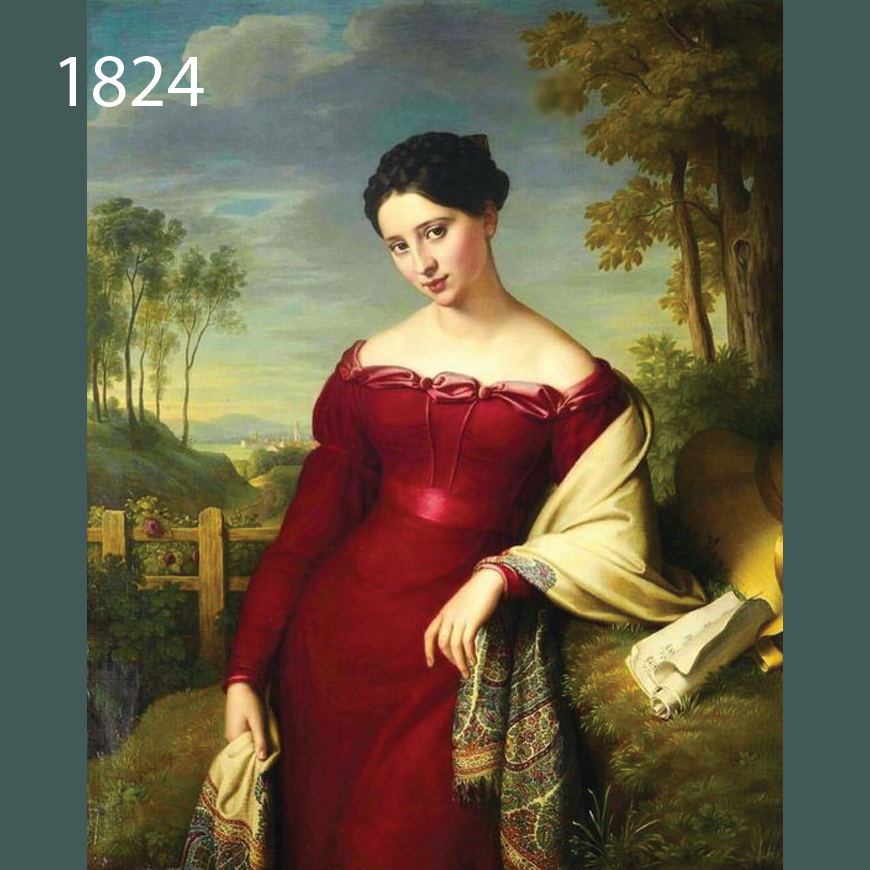
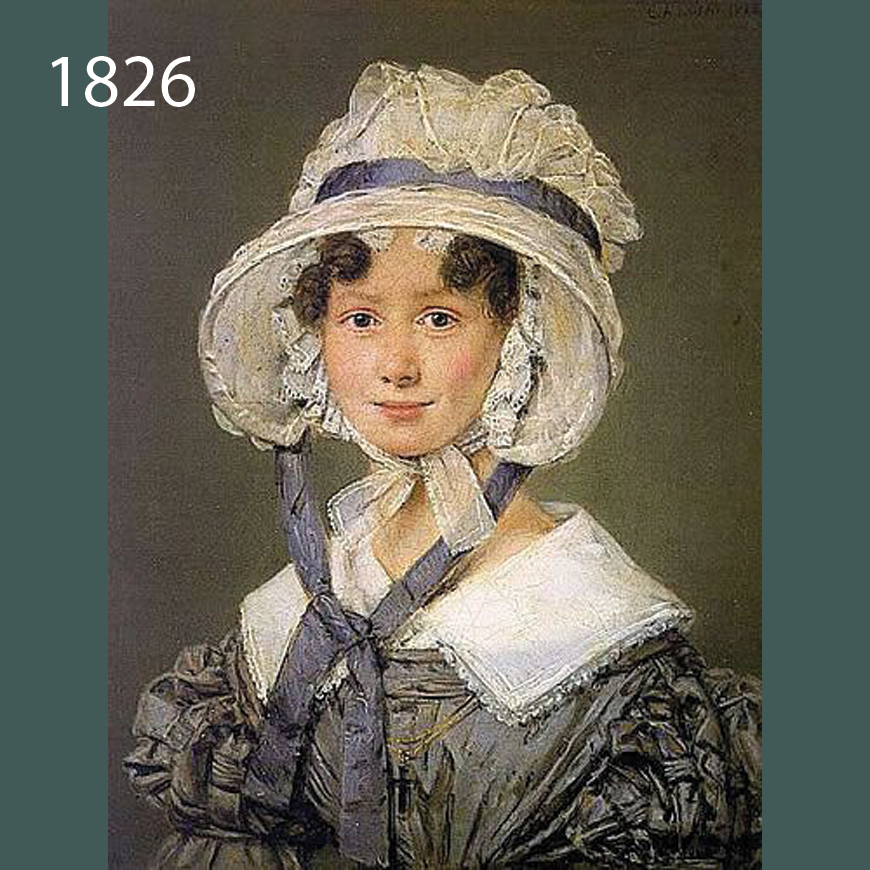
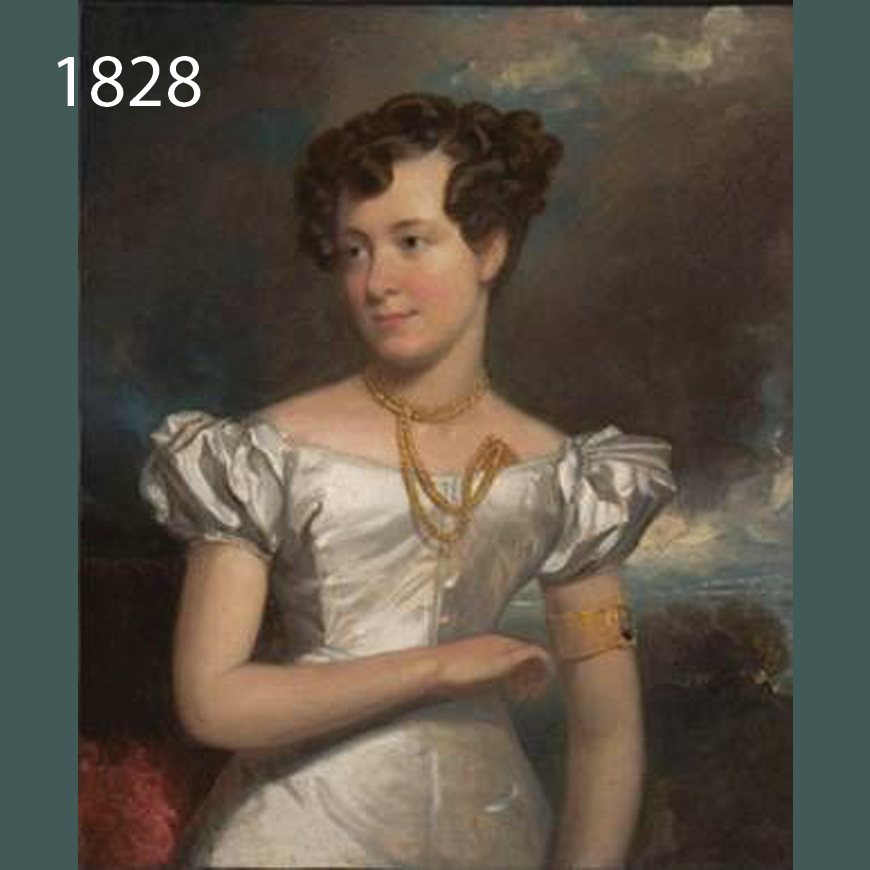
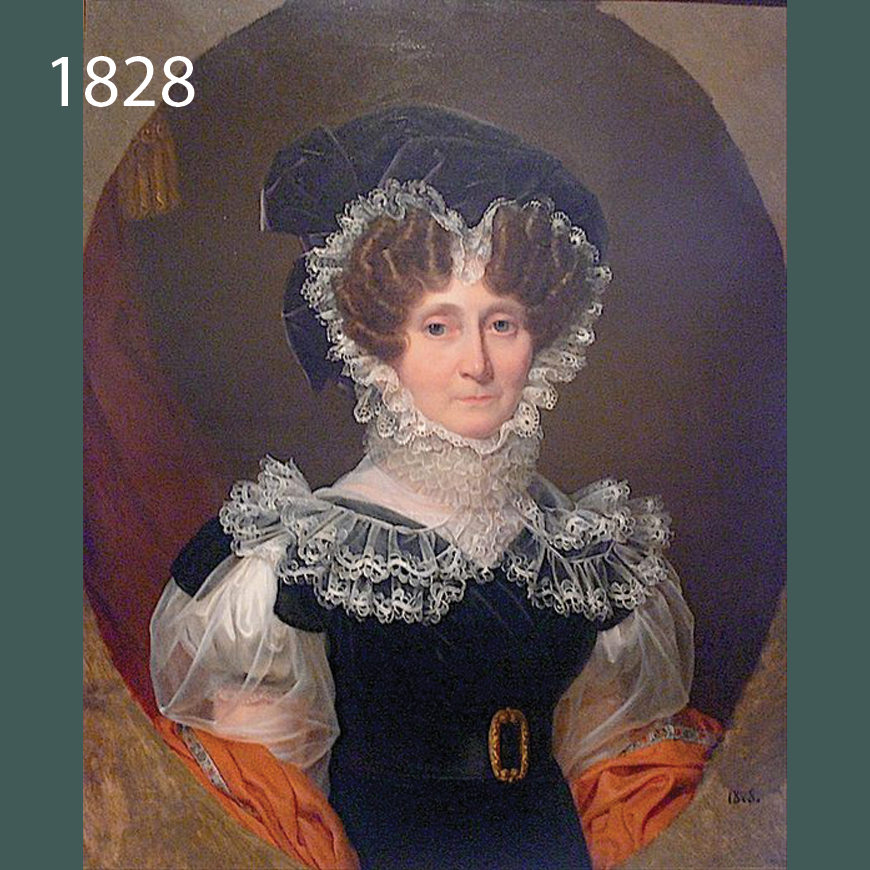
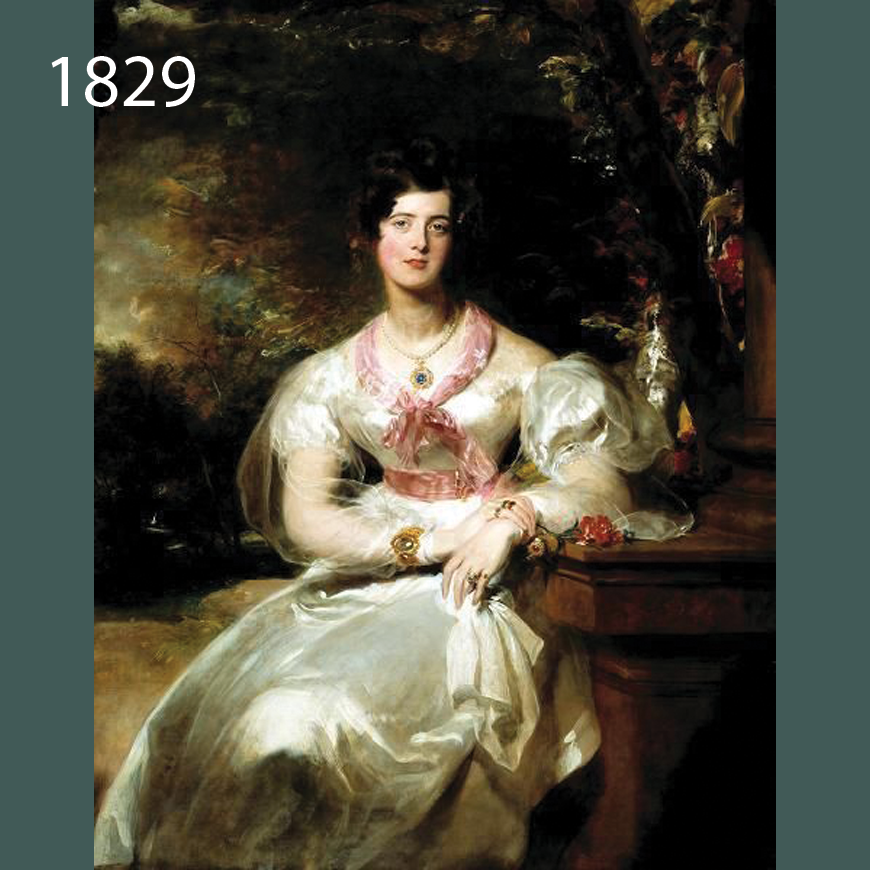
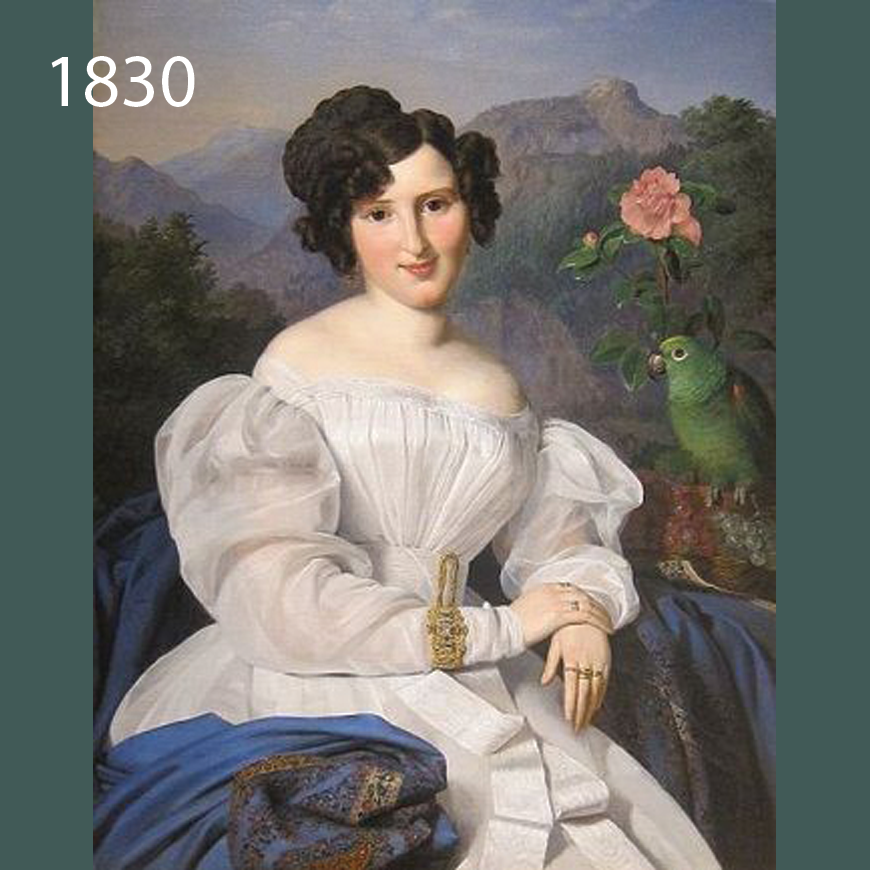
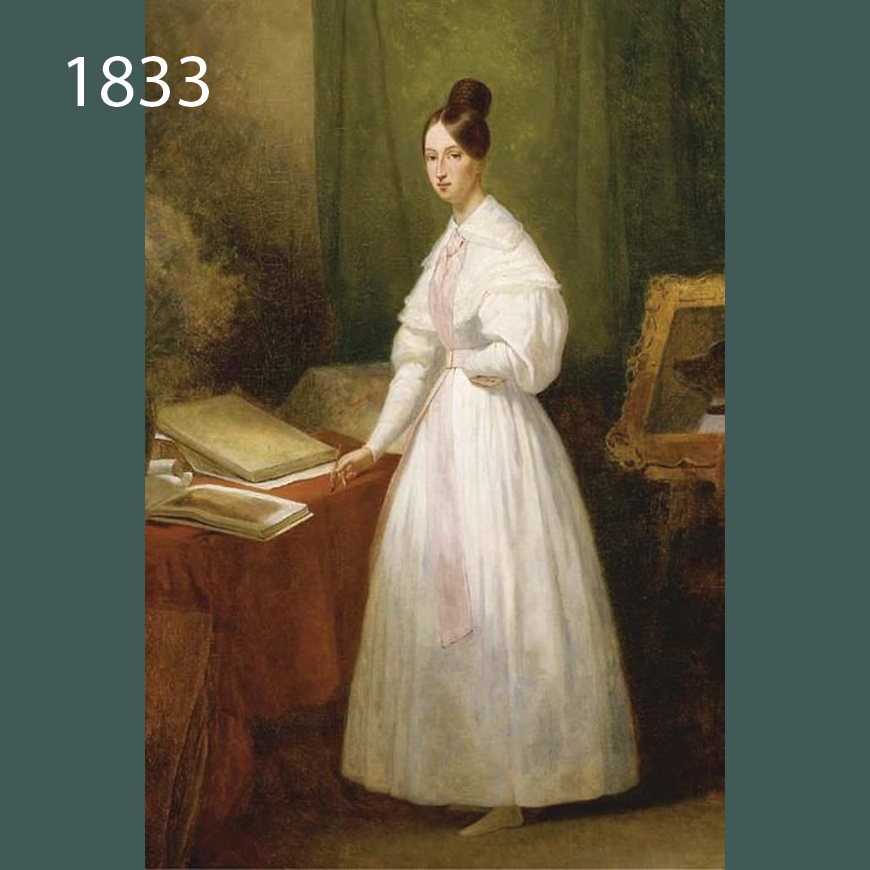
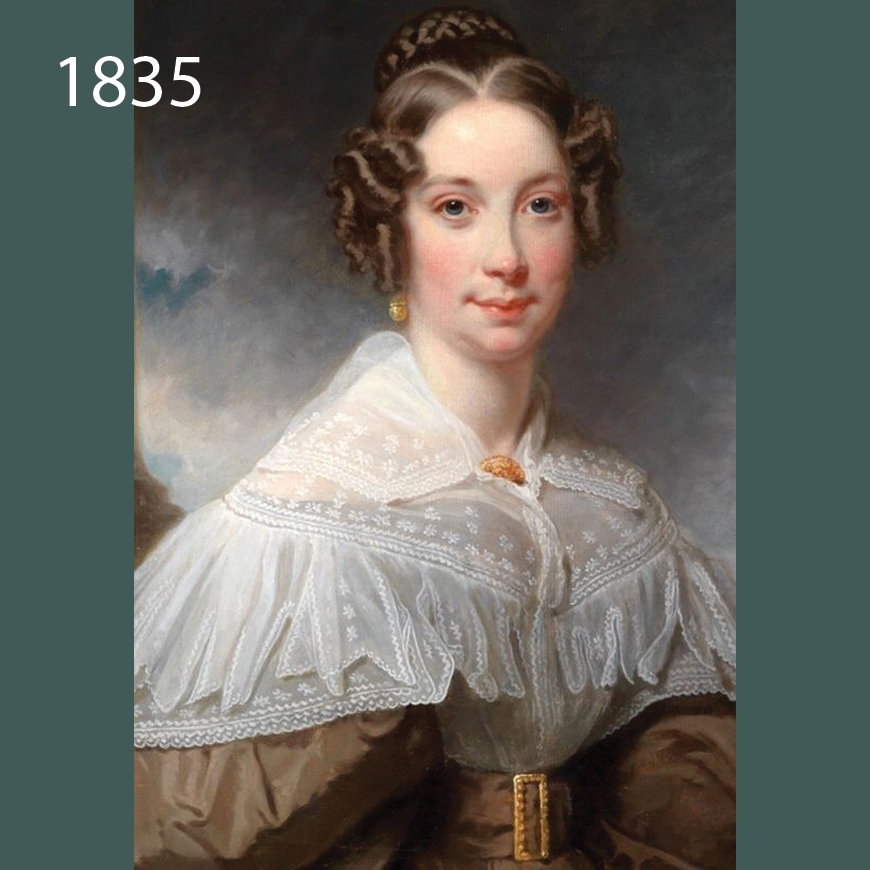
—— WORLD SITUATION ——

NEW BOUNDARIES
- The end of the 1820’s saw the rise of Romanticism
- The world was relatively peaceful & prosperous, at least compared to the prior 50 years of war & conquest on every continent
- Women at this time had the most freedom they had yet in history
- The era included freedom in manners & physical movement (e.g. travel) for all classes & genders
- Women were establishing new roles
- The 19th century was a time when hard work & not just your birthright could have you go from rags to riches or from a log cabin to the White House
- Legal reforms, particularly in England & America regarding slaves, women, & criminals made a century full of heroines from Josephine to Queen Victoria to the Gibson Girl of the 1890’s
- America was tracking election results & had developed bureaus for everything including Indian Affairs
- Charles X was the last Bourbon king to rule France
- Wealth was the common language of the century
- Major countries that had been in conflict finally established peace treaties & agreed upon border lines
- Russia set permanent boundaries in North America
- Brazil, Mexico, Bolivia, & Uruguay all become independent after years of occupation
- Liberia was established by freed American slaves as an independent country on the African continent
- Siam & Britain were at peace at last, although Britain declared war on Burma
- Britain & the Netherlands settled into a trade agreement after years of conflict
- Tension in America between Native Americans was easing as Indians were settled on reservations
- The removal of Cherokee from Georgia was of terrible consequence. The “Trail of Tears” ended Native American suppression as most tribes were moved west of the Mississippi
- The princess of Java declared war on all non-Islams, & through the era would attack peaceful settlements of all nationalities
- The Greek War of Independence continued conflict with the Turks
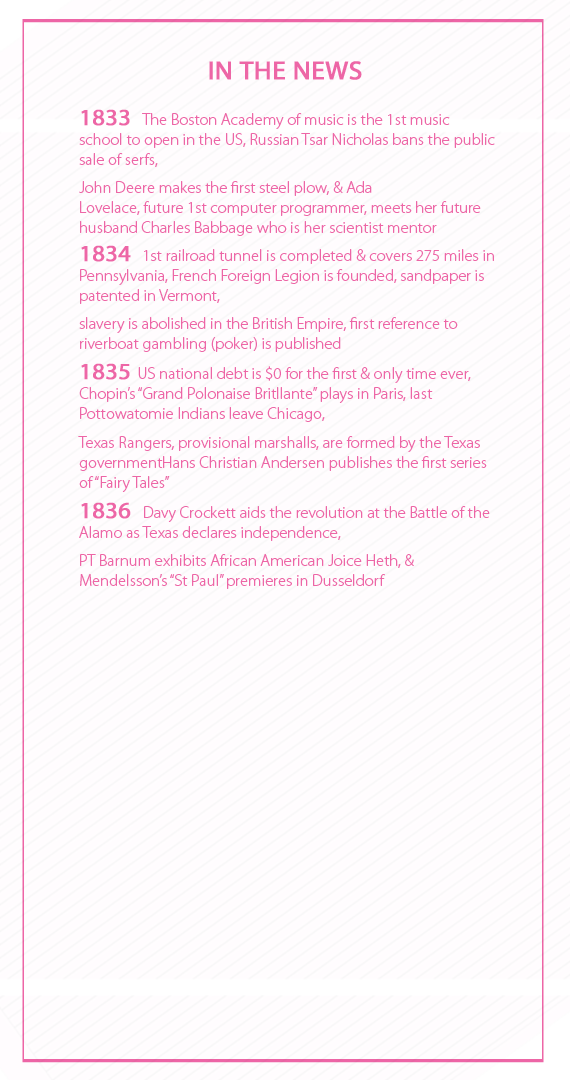
INNOVATION
- It was a time of yet more innovation. The removable collar was invented by a woman in New York
- Inventions included the washing machine, tin can, first suspension bridge, portland cement, canals, friction striking match, & the combustible engine “Gas or Vapour”
- Transportation boomed: canals were completed & the USS Vincennes the first warship to circumnavigate the globe
- The first complete railroads for steam engine were finished in Stockton-Darlington, England, & Massachusetts
- Organizations such as the Altheanaeum Club in England, the New Harmony “Utopian” settlement by a Scottish factory owner in Indiana, & the colony at Salt Lake City, Utah by Jedediah Smith & the Mormons, brought new concepts & philosophies of living
- Many colleges & universities were established in the US & Britain
- Lord & Taylor opened the first American department store in New York in 1826, & New York City opened the “5th Avenue” shopping district
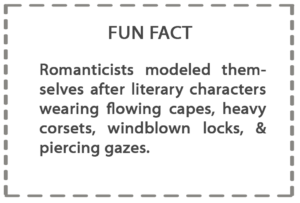

—— INTERESTING FACTS ——
THE LIBERATED WOMAN… EXCEPT
- Society as a whole was less restrictive in the early 1820s than it would be for the next hundred years
- Women’s freedoms came from:
- Technology that reduced their drudgery
- Communication that allowed them to understand (if not yet participate) in world & local politics
- The ability to participate in invention (& particularly science & manufacturing)
- Freedom to express their thoughts
- Economic stability – particularly of a strong middle class in America – & a type of affluence that was not necessarily comfortable, but was not limiting
- The concept was being accepted that a woman could rise financially, socially, & spiritually through her own actions & efforts
- Into this freedom, in the mid-1820’s entered the sobering concept of “Ideal Womanhood”
TIED DOWN BY ROMANCE
- The Romantic era represented the “Ideal of Womanhood” which would be learned & expressed through fashion
- The “Ideal of Womanhood” dictated that a woman’s objective in life was to be morally pure, stay close to home, & to shape the world through her calming influence on her man
- Romanticism appealed to people who were yearning for simpler, nobler times when troubadours sang of chivalry & hopeless love, as an escape from the real world into a world of mystery & intrigue
- Men were to protect their woman from a world thought to have become harsh & dangerous due to the advance of technology
- Part of the schooling of women to their new role came through trends in fashion
- Romanticists modeled themselves after literary characters, wearing velvet capes, heavy corseting, windblown locks, & piercing gazes
- Romanticism would challenge the bourgeois values, social conformity, & class structure
- This “Age of the Genteel” began in this era to teach a distinction of class through thought & behavior, most likely to regain lost social structure
- It is thought the subsequent Victorian & Edwardian eras might have been a “pendulum swing” in response to this time of freedom, back to a time of rules & restrictions
- It is also thought that forcing women to wear petticoats again, & to exercise “prudence” in an otherwise free & exciting time for them kept their newfound independence in check
WHILE THE INDUSTRIAL REVOLUTION MARCHES ON
PHOTOS
- The final months of the 1830’s saw a revolutionary new technology: photography.
- Portraiture preserved for the first time images of the real behavior of human beings: what they were wearing & how they behaved in it
- From the furthest reaches of the American west to the fashion houses of Paris, people could see each other as they really were through photographs
FABRICS & DYES
-
- In America, there was a great variety of fabrics available for making clothes
- American fabrics were all “natural”: wool & linen being most common, with cotton & silk scarcer & more expensive as they had to be imported until US mills began producing finished cotton in the late 1820’s
- Hundreds of weaves & patterns were available worldwide
- There were many innovations in roller printing on textiles
- A rich selection of colors existed even before synthetic dyes would be developed in the late 1850’s
- Early colors were made from plants
- Leaves, stems & blossoms were used from trees & flowers of the woods & meadows
- Roots, barks, nut hulls, tree galls, berries, fruits, pits, skins, mosses, lichens, & fungi were used
- Non-plants, such as insects & shellfish were used to make dyes
- Many dye sources were imported from tropical areas, & were sold in general stores where they were widely available to both home & commercial dyers
- Professional dyers sometimes supplied services directly to home spinners & weavers
- Rich colors such as the Turkey red fabrics of the 1820s were still found, but delicate floral prints on light backgrounds were increasingly more popular
- More precise printing eliminated the need for dark outlines on printed designs, & new green dyes appeared in patterns of grasses, ferns, & unusual florals
- Combinations of florals & stripes were fashionable


1827-1851
Expansion of ideas, inventions, & dresses
—— THE ERA IN BRIEF ——
Society in American & Europe were prospering with the development of great ideas like indoor plumbing & the shopping mall. With the invention of the crinoline hoop skirt & metal grommets, women made themselves into “Belles” literally & figuratively, following the lead of a tiny-waisted 18 year old Queen Victoria of England who had just taken the throne. At the same time “49’ers” were panning for gold in California, Charles Worth was inventing a “costume” for every event, while paisley was up & bloomers were down in popularity.

—— PORTRAITS OF REAL WOMEN OF THE ERA ——
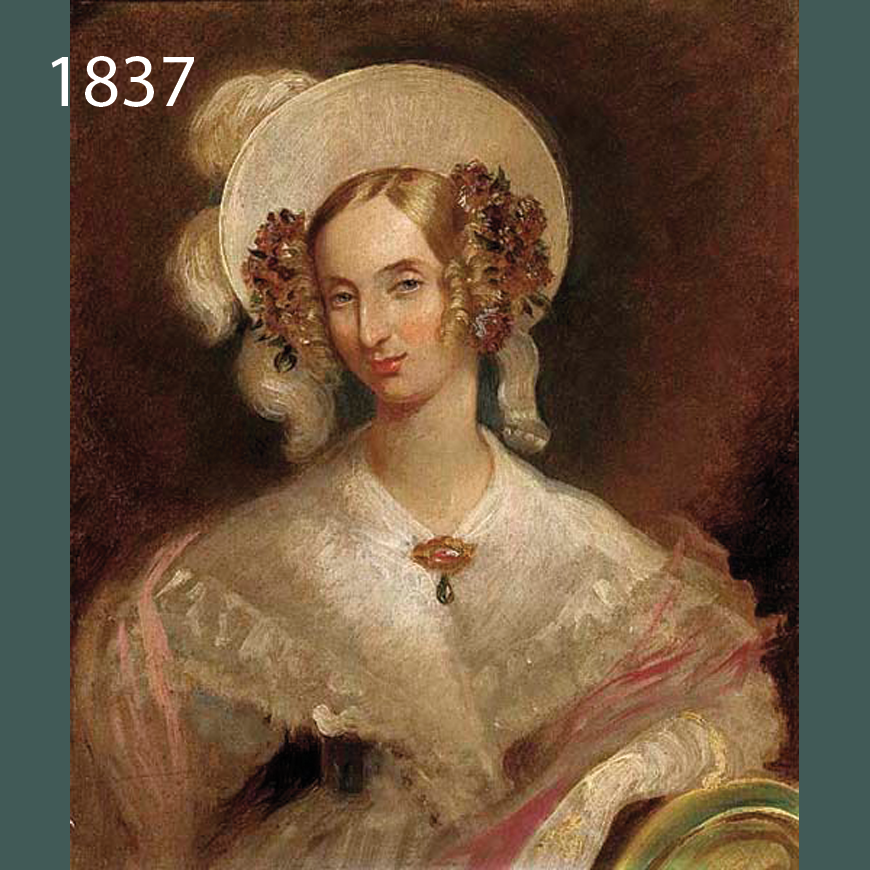
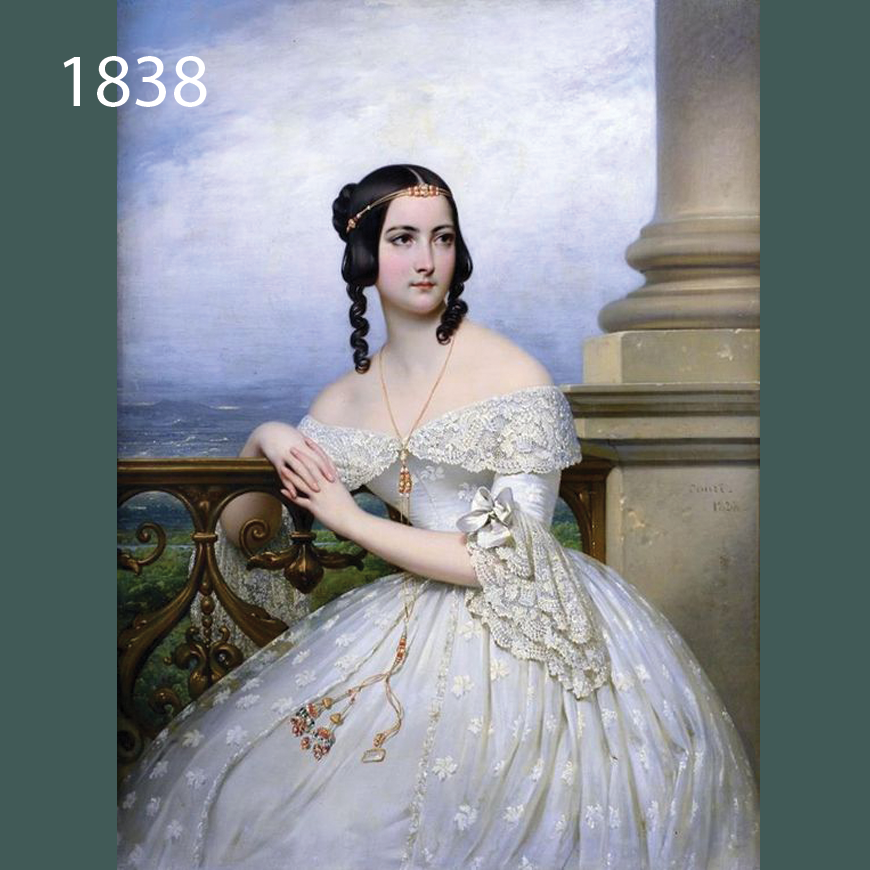
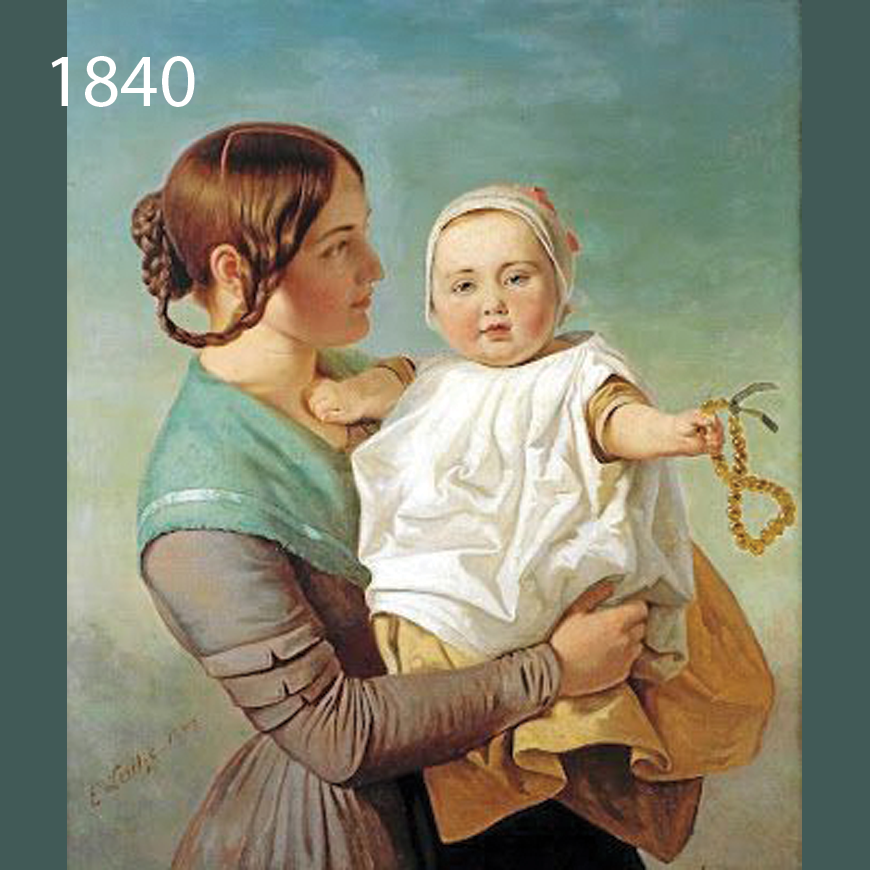
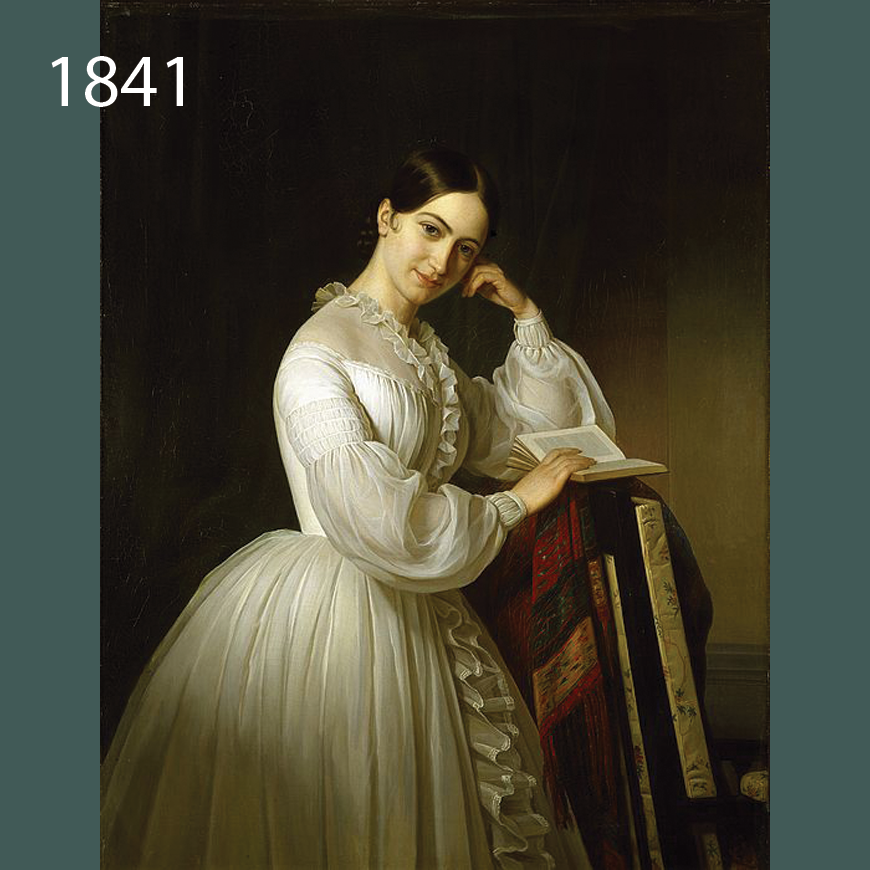
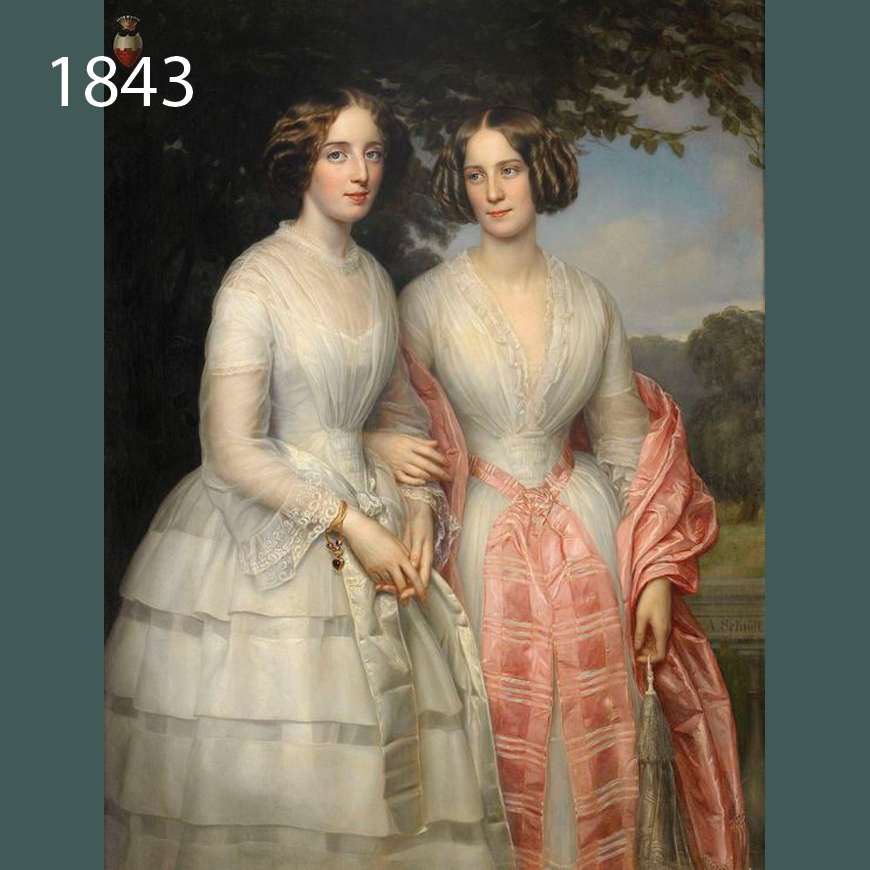
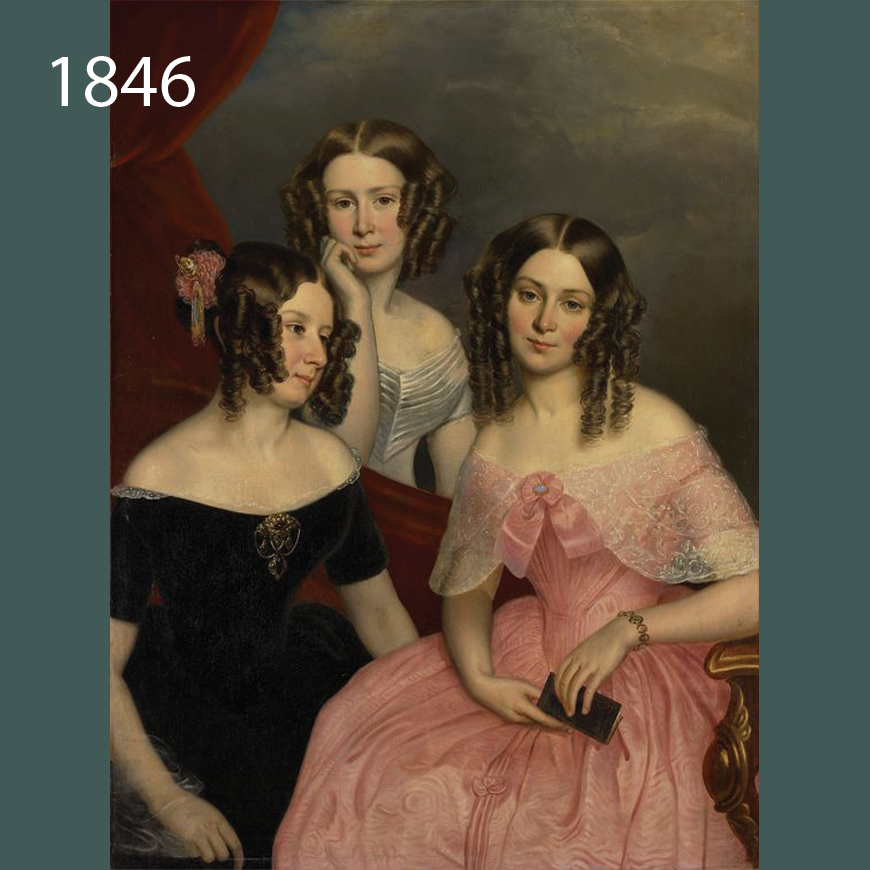
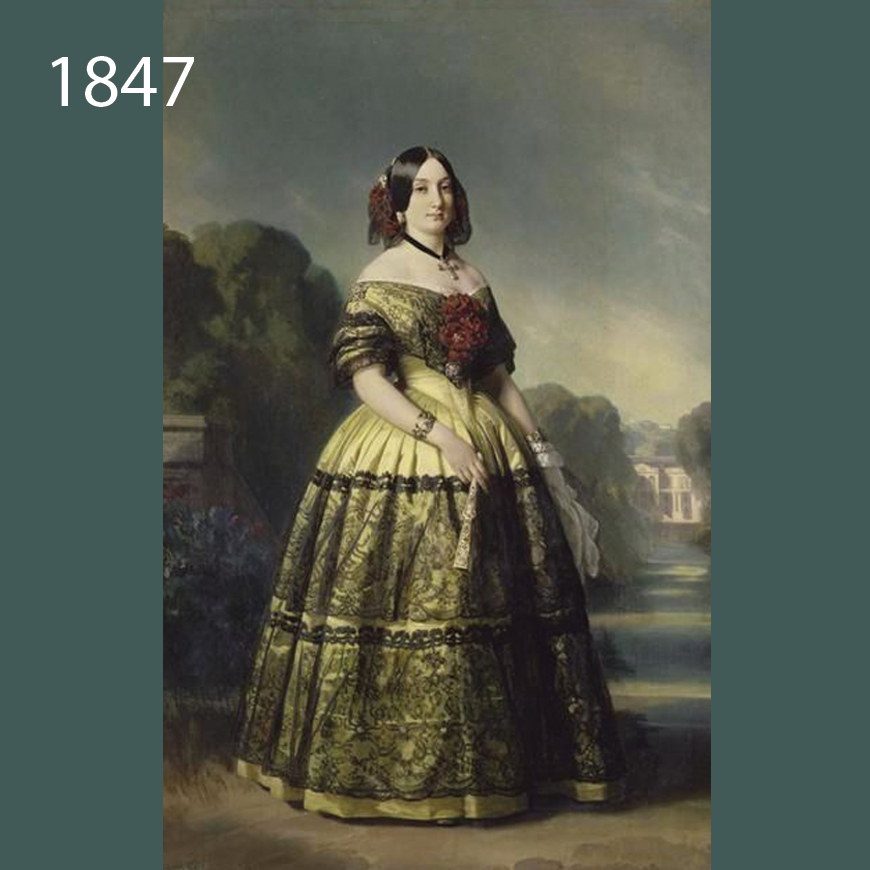
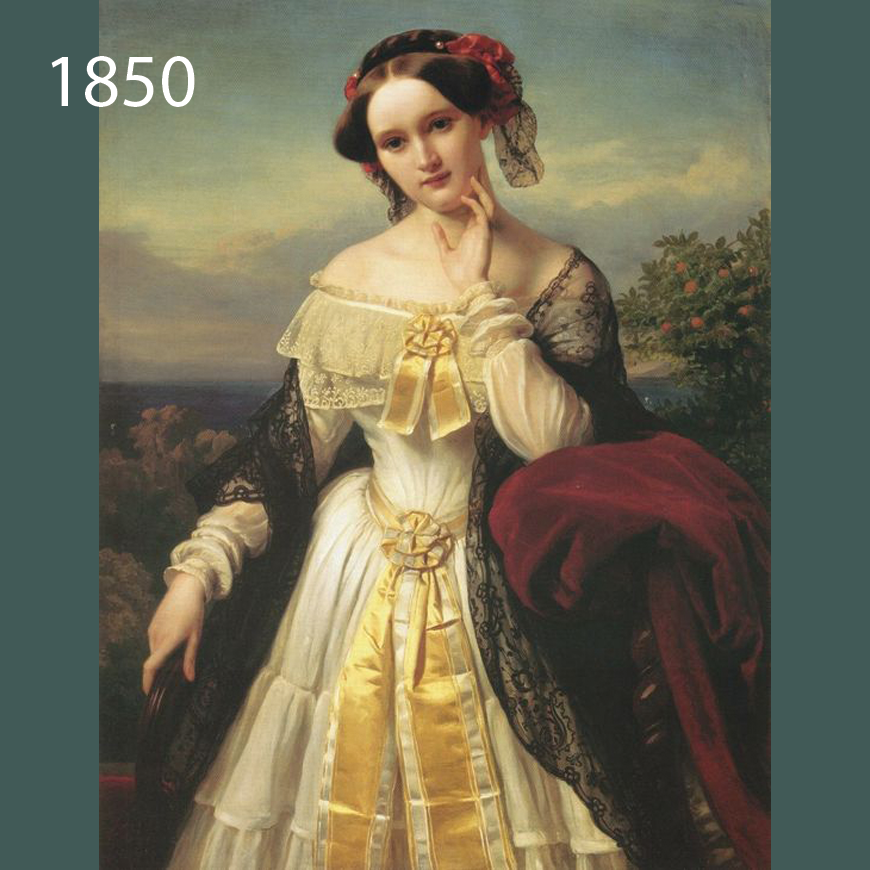

—— WORLD SITUATION ——
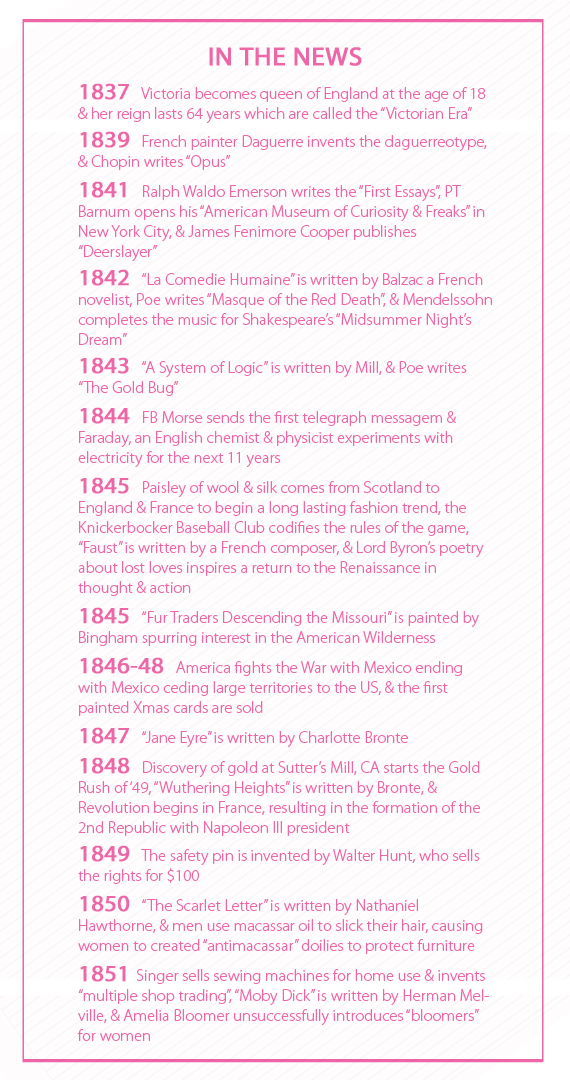
- Queen Victoria came to the throne in 1837 at the age of 18, & would dominate history & world fashion until the next century
- Victoria’s rigid disciplinary standards for 64 years set the “Victorian Eras”
- Under Victoria’s rules, it was improper to even say the world “legs”, let alone look at them under a woman’s garments during this era
- Everything Victoria did was to spur the English economy
- Countries worldwide flourished with improvements on steam engines in all industries & science
- Indoor plumbing, gas lighting, & fast transport changed lives & status of all classes & peoples
- America acquired Nevada, New Mexico, & California in 1848 in a treaty with Mexico
- There was another Revolution in France in 1848, which cut off communication & trade from that country & others
- Gold was discovered in California, starting the gold rush & western expansion in the US
- America went to war with Mexico 1846-48, ending with Mexico ceding large territories to America
- Literature such as “Moby Dick” & “Uncle Tom’s Cabin” expressed ideas of pre-Civil War in America

 Women’s Changing Roles in the 1830’s & 1840’s
Women’s Changing Roles in the 1830’s & 1840’s
There was in Massachusetts in America in the early 1840’s, a mill that attracted young women away from farms and home industries to the factories; specifically the Lowell Textile Mill.
Unlike many of our perceptions of girls leaving home to support the family, and working in the new industrial revolution factories where they were abused, there was a type of “Camelot”, a short period in history where women were free to make the choice to go out and earn money on their own – and to keep it and to provide for themselves as single women.
Rather than plagerizing this well researched and documented article that is distributed with permission of the Lowell Mill Historical society, we will cite the original sources, and provide this as image files.
What we take from this for Emma’s ensemble, is that young girls actually LIKED to work, and they LOVED being independent and supporting themselves. It was a rare time in history when women could be free to do what they wanted without being tied to a father, brother, husband, or other man in some way. While the “Mill Girls” were well chaperoned and cared for somewhat like in our later history the “Alma Mater” concept of higher education would provide, they were still very much on their own.
For character depictions like Emma’s, where one of the eldest children is working at an inn, we take special note here that it might not have just been to give money to the family. It very likely was because there was a great amount of satisfaction in making something yourself, doing a good job, working hard, and seeing the results of your efforts so that you could grow and improve your situation by those efforts.
In that, the girls of the 1830’s were not so much different than many young women today.
“The Early Years in Lowell, Massachusets, 1821 through 1841”
Written by Elizabeth M. Mahan, edited by Martha Mayo, with permission to pastpatterns.com by the Lowell Historical Society
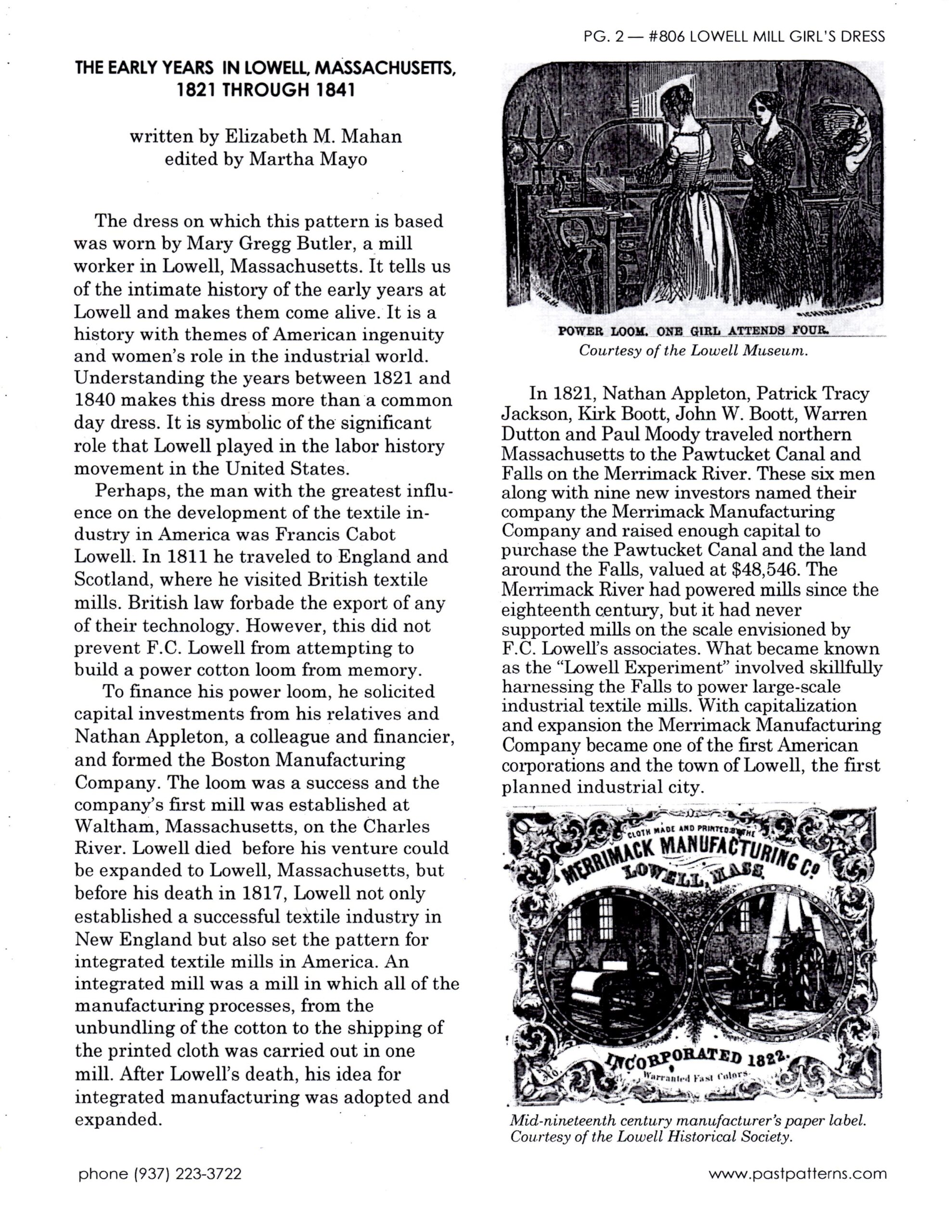
—————————————————————————————–
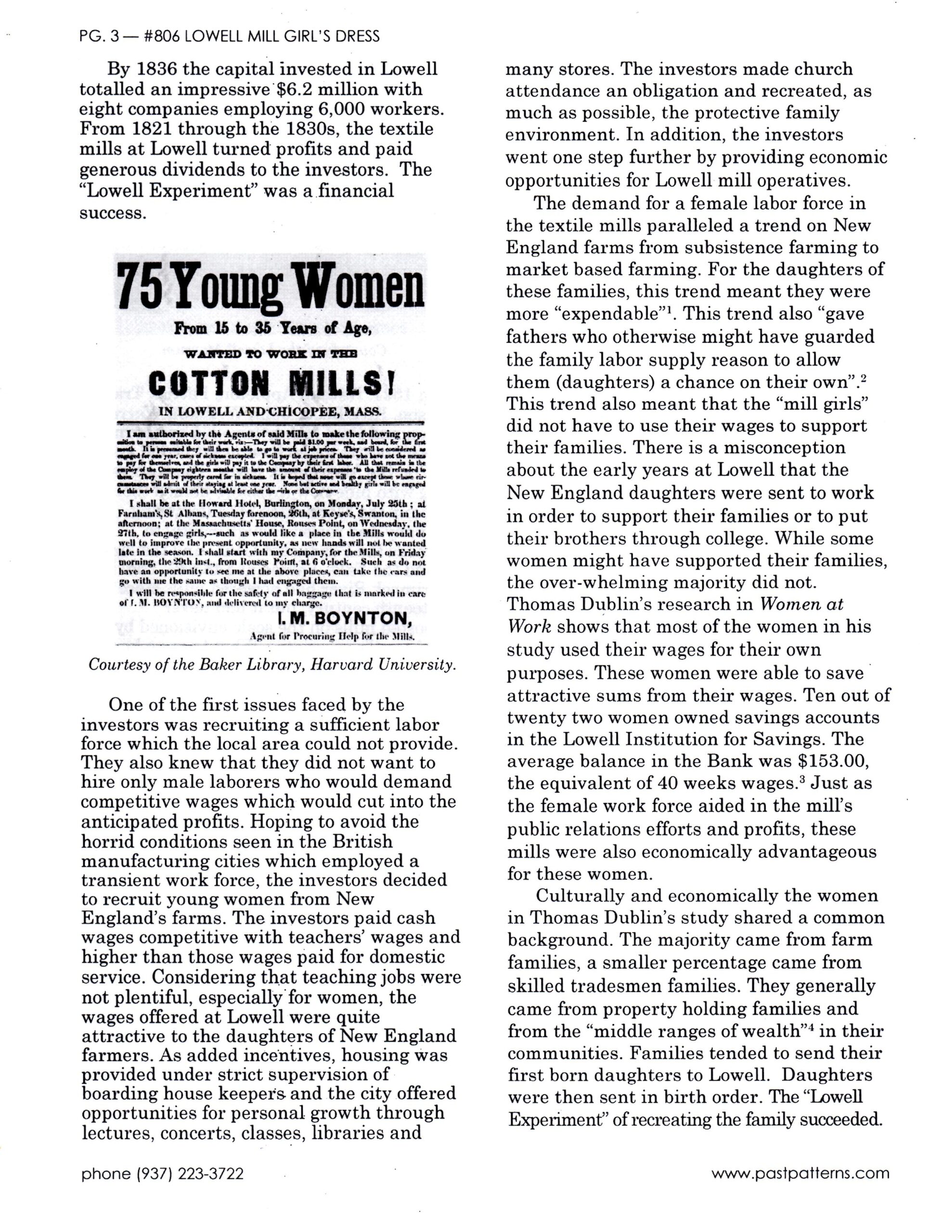
————————————————————————————-
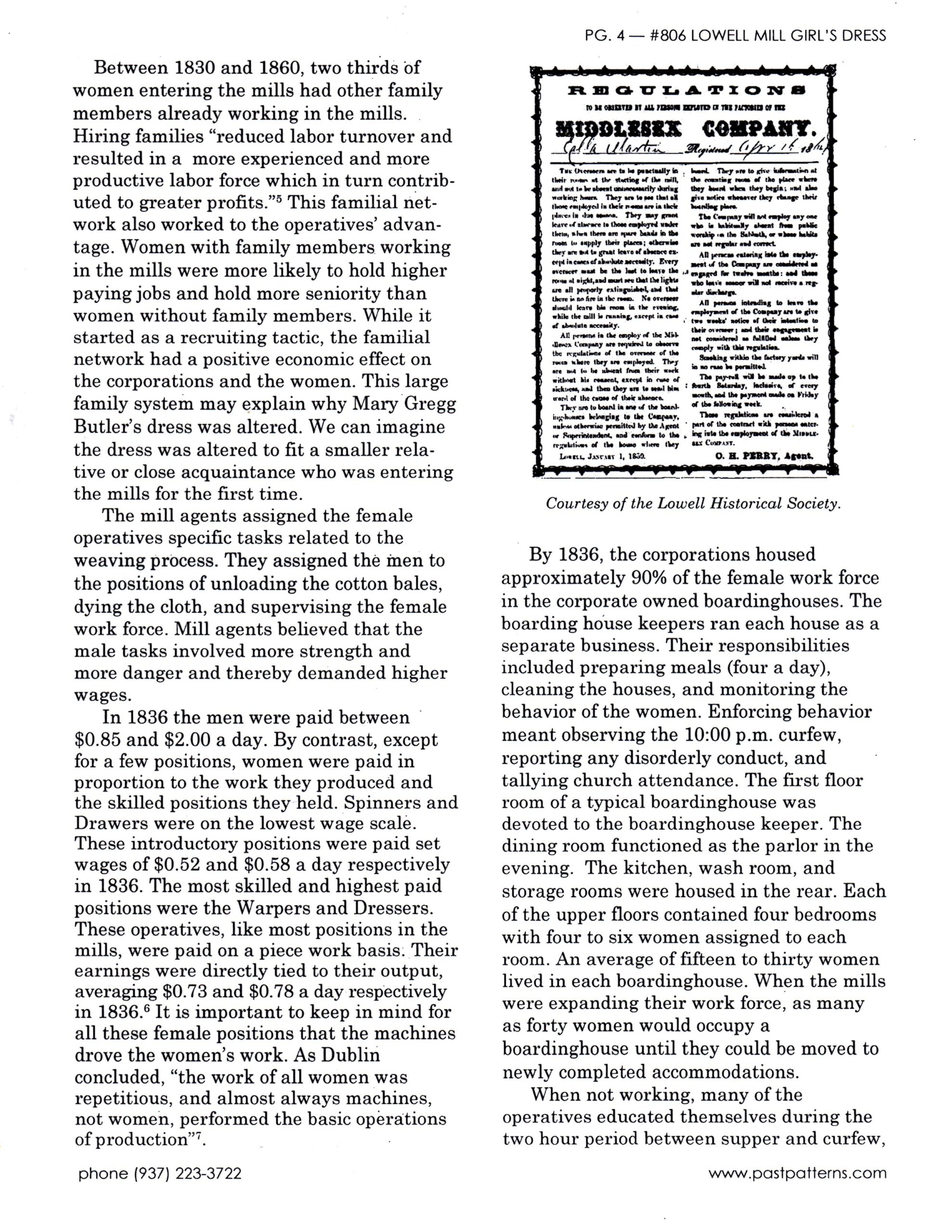
—————————————————————————————-
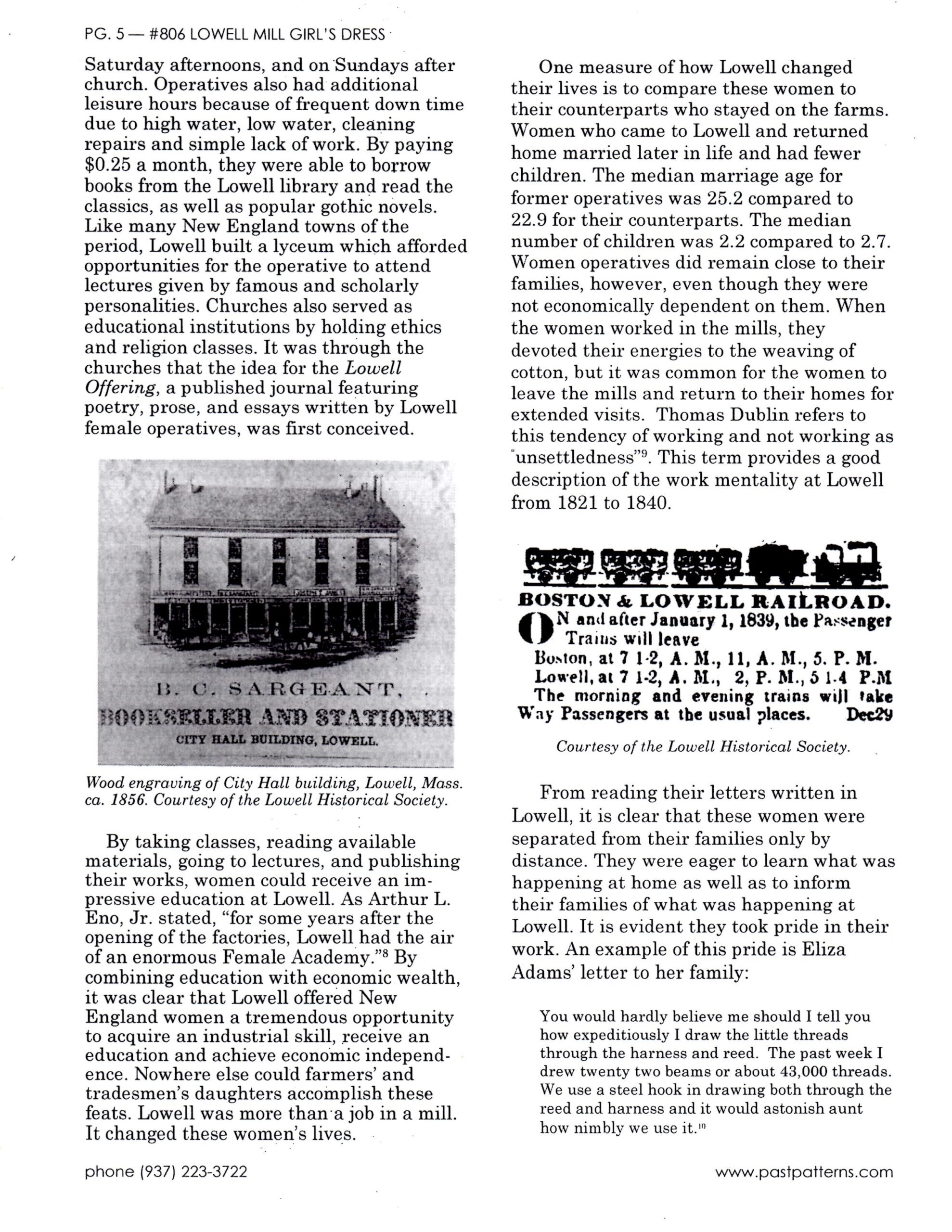
————————————————————————————————–
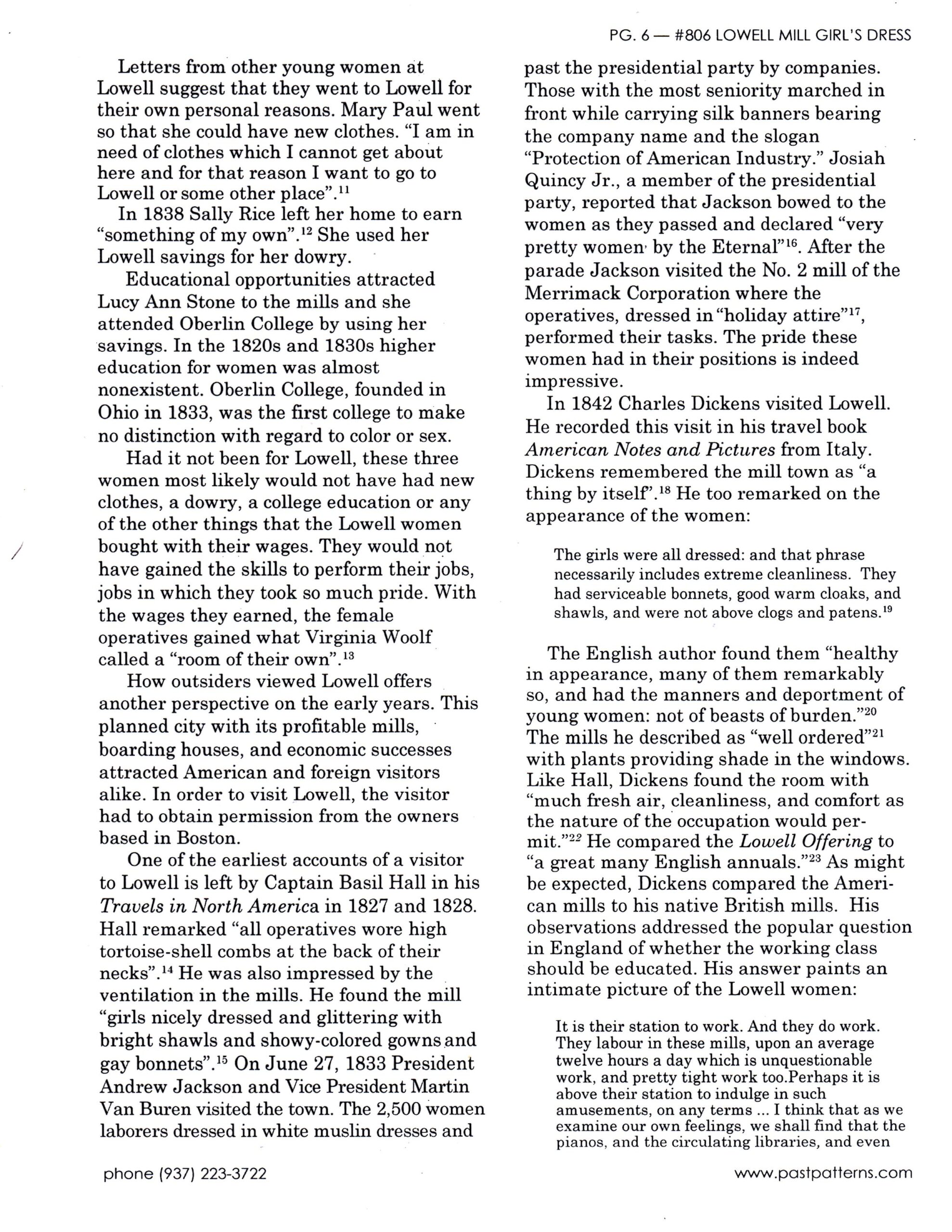
————————————————————————————————–
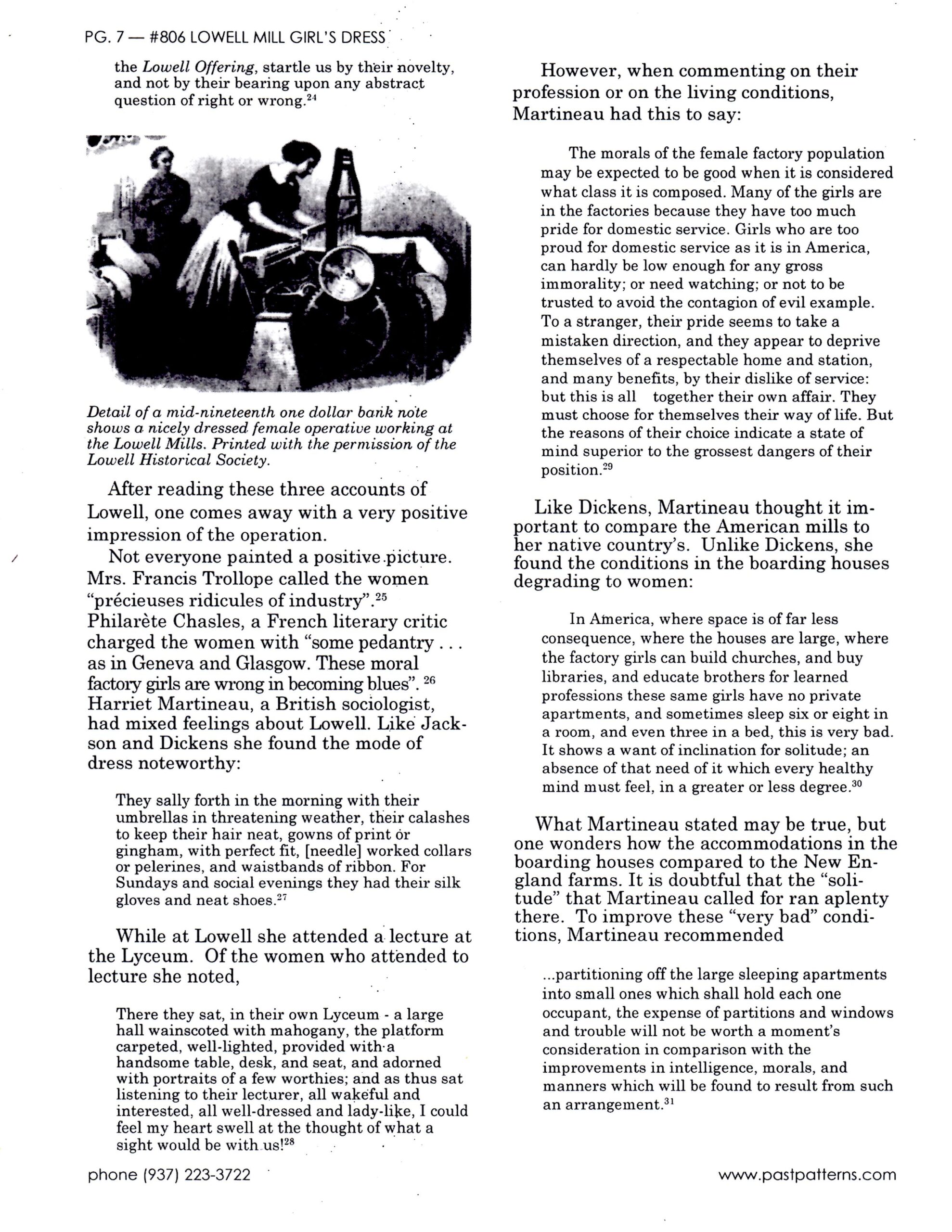
———————————————————————————————-
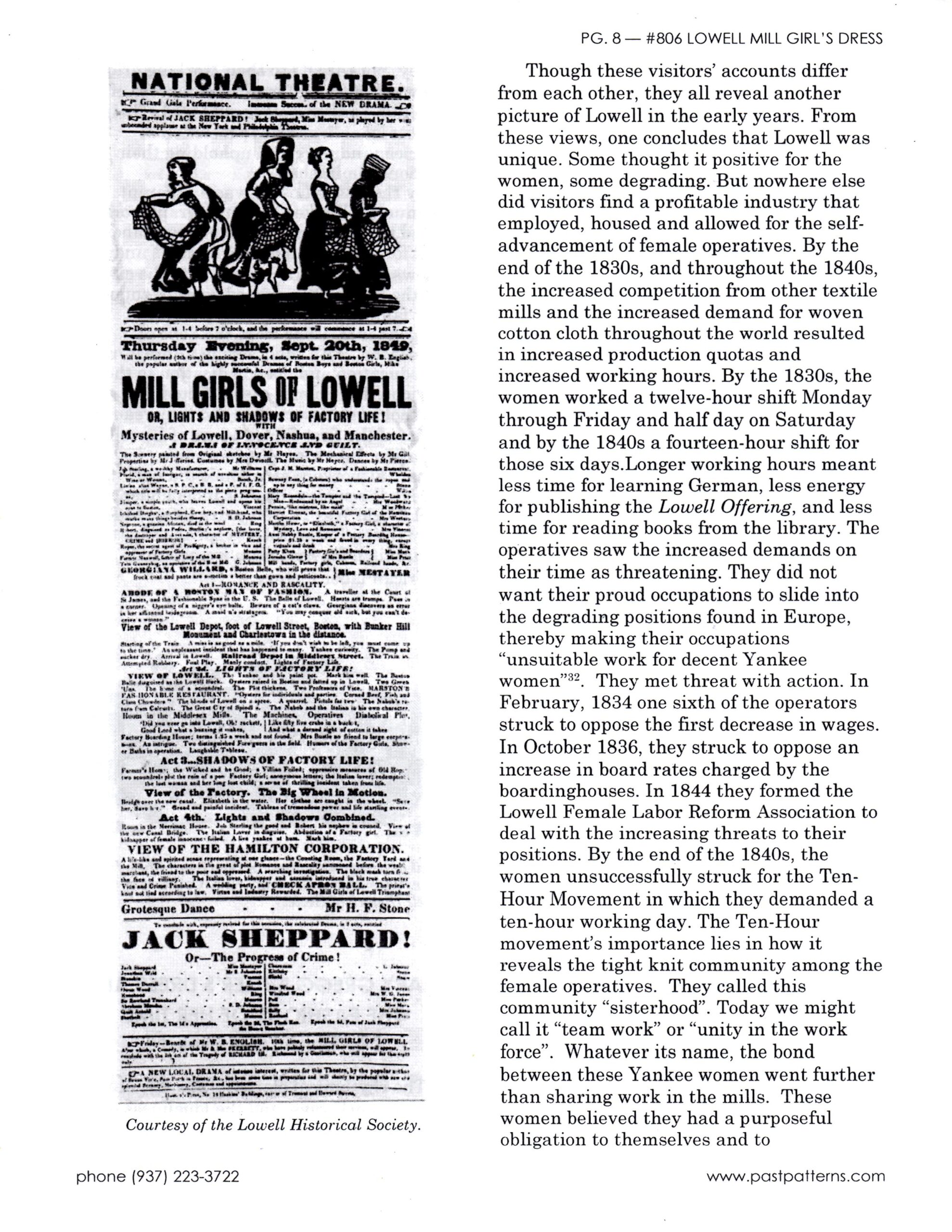
—————————————————————————————–
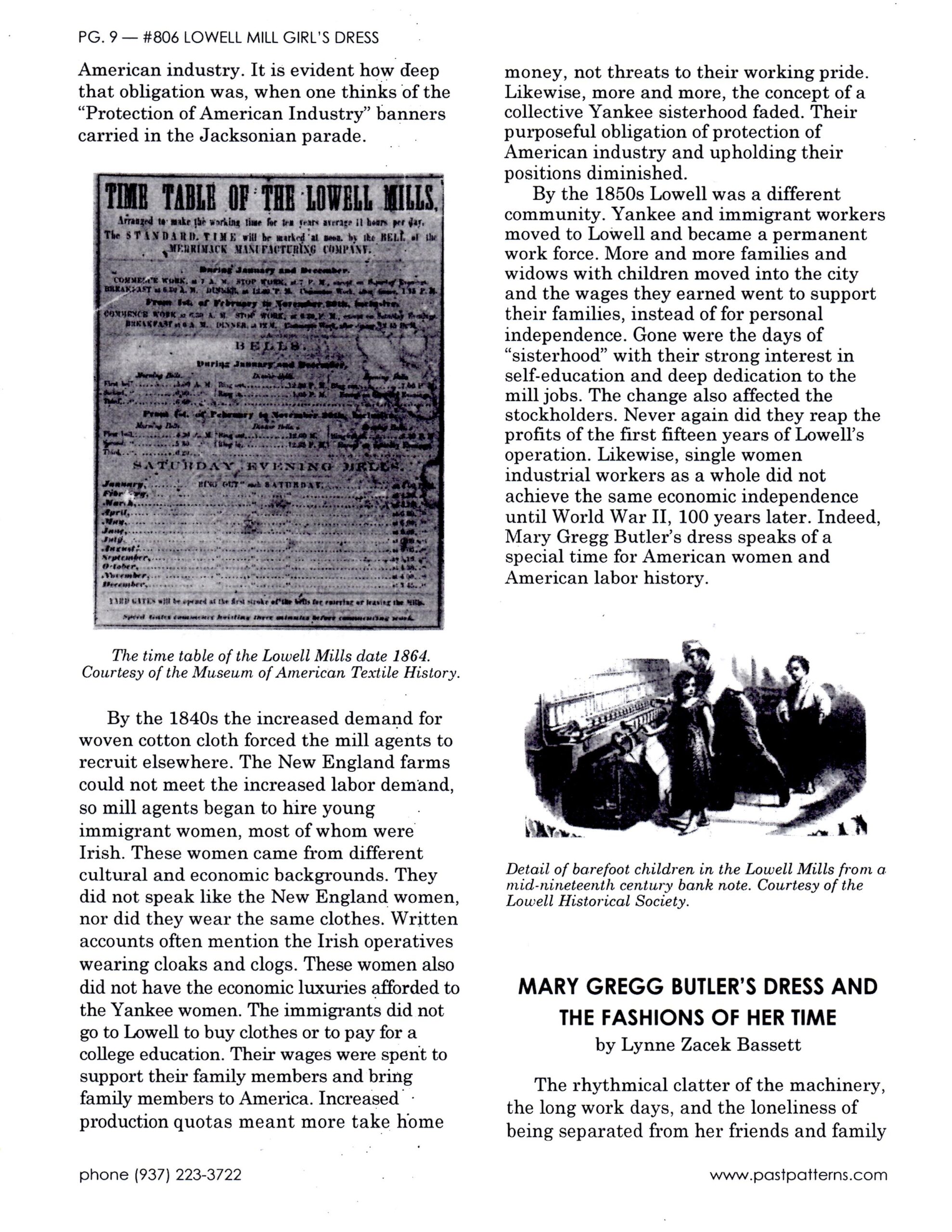
—————————————————————————————————-
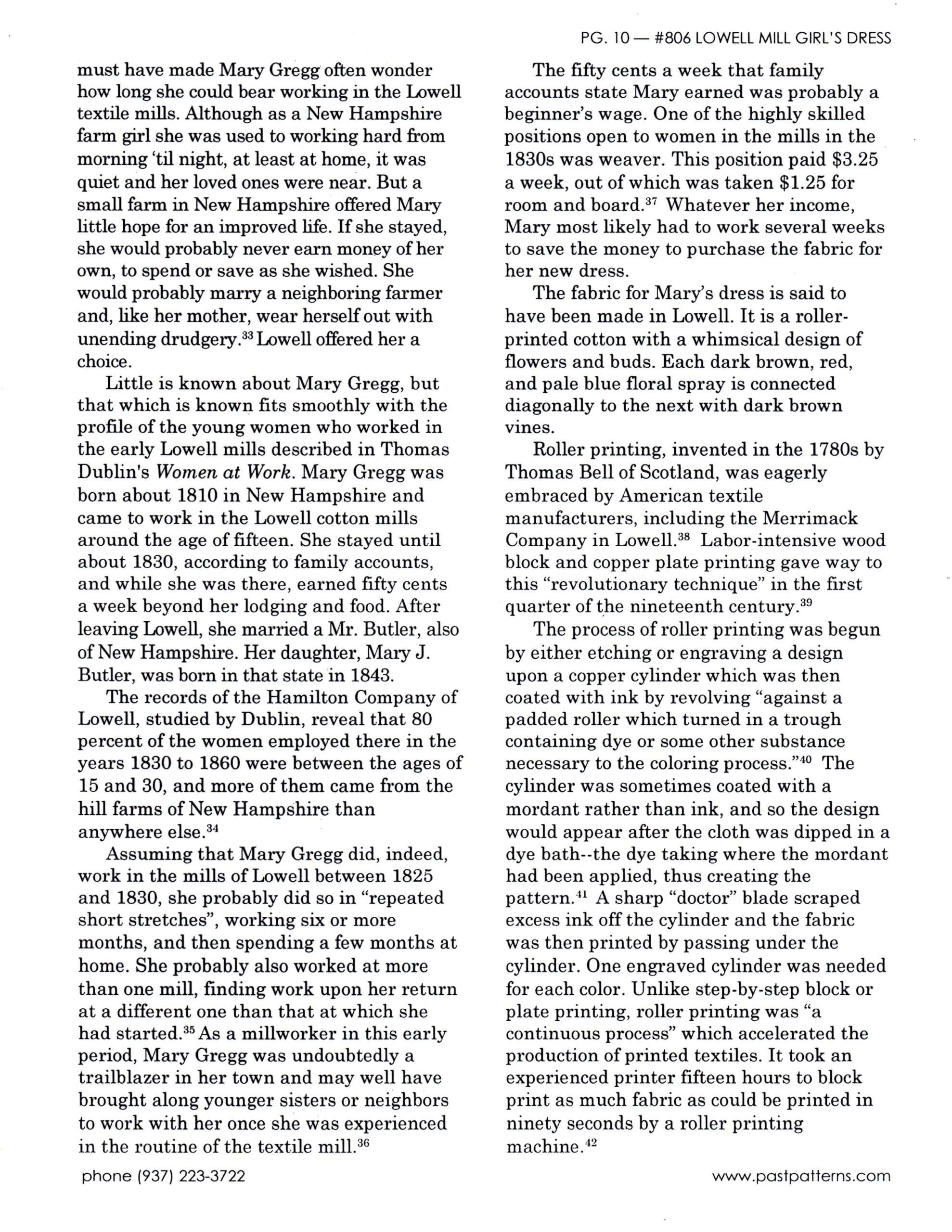
————————————————————————————————–
Click here to go to Emma’s Fashion History Page (next)
Click here to go to Emma’s Design Development Page
Click here to go to Emma’s Main Page with the finished project
